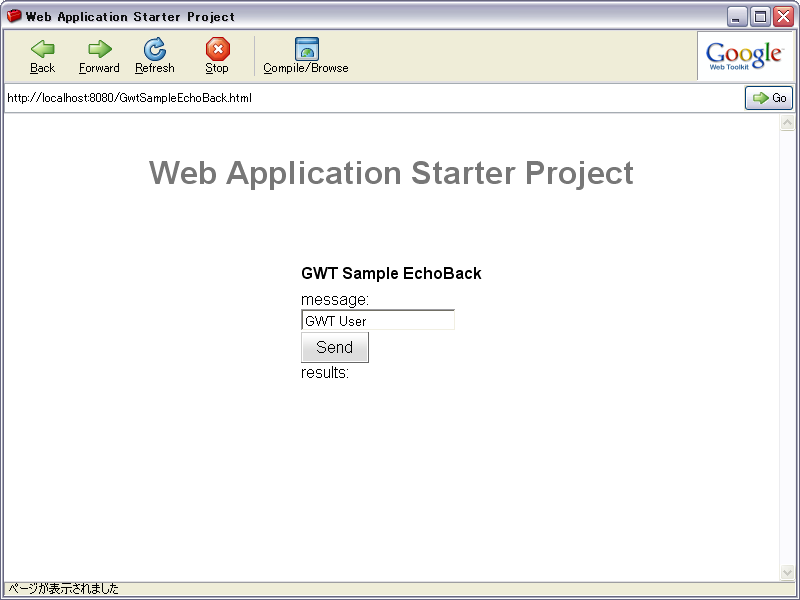GWTでエコーバックを非同期通信でする
ボタンとテキストボックスを配置し、テキストボックスに文字を入力し、ボタンを押す。
サーバに入力文字列を渡し、そのまま返すプログラム。
サーバ間通信は非同期で行う。
というアプリを作成する。
■プロジェクト概要
プロジェクト名:GwtSampleEchoBack
使うソース
■サービスの作成
GreetingService
Stringを受け取り、Stringを返すechobackメソッドを定義する
public String echoback(String name);
GreetingServiceAsync
GreetingServiceと対になるechobackメソッドを定義する
AsyncはServiceの戻り値をAsyncCallbackのジェネリクスに指定し、戻り値は持たない
void echoback(String input, AsyncCallback<String> callback);
■GreetingServiceImpl
GreetingServiceを実装したGreetingServiceImplの作成
GreetingServiceImplにechobackメソッドの処理を実装する
public String echoback(String input) { System.out.println("Rec: " + input); return input; }
ついでに、呼び出し前処理と、呼び出し後処理のメソッドも追加する
@Override protected void onAfterResponseSerialized(String serializedResponse) { System.out.println("After: " + serializedResponse); } @Override protected void onBeforeRequestDeserialized(String serializedRequest) { System.out.println("Befor: " + serializedRequest); }
■GwtSampleEchoBack
クライアント側の作成手順
- リモートサービスの呼び出しインタフェースを取得
- Widget初期化
- sendButton リモートサービスの呼び出し
- nameField 送信文字
- results 受信文字
- serverResponseLabel Error文字
- ButtonにClickHandlerを実装
- callbackの作成
- 呼び出し
リモートサービスの呼び出し用のインターフェースを取得する
private final GreetingServiceAsync greetingService = GWT.create(GreetingService.class);
ClickHandlerを実装とcallback作成
sendButton.addClickHandler(new ClickHandler(){ @Override public void onClick(ClickEvent event) { //callback作成 AsyncCallback<String> callback = new AsyncCallback<String>(){ @Override public void onFailure(Throwable caught) { results.setText("Server Response Error"); serverResponseLabel.setHTML(caught.getMessage()); } @Override public void onSuccess(String result) { results.setText(result); } }; greetingService.echoback(nameField.getText(), callback); } });//end of addClickHandler
■ソース
■GreetingService.java
package sample.echoback.client; import com.google.gwt.user.client.rpc.RemoteService; import com.google.gwt.user.client.rpc.RemoteServiceRelativePath; /** * The client side stub for the RPC service. */ @RemoteServiceRelativePath("greet") public interface GreetingService extends RemoteService { /** * クライアントから送信されたメッセージをそのまま返す * @param name クライアントからの送信文字列 * @return サーバからの返信文字列 */ public String echoback(String name); }
■GreetingServiceAsync.java
package sample.echoback.client; import com.google.gwt.user.client.rpc.AsyncCallback; /** * The async counterpart of <code>GreetingService</code>. */ public interface GreetingServiceAsync { void echoback(String input, AsyncCallback<String> callback); }
■GreetingServiceImpl
package sample.echoback.server; import sample.echoback.client.GreetingService; import com.google.gwt.user.server.rpc.RemoteServiceServlet; /** * The server side implementation of the RPC service. */ @SuppressWarnings("serial") public class GreetingServiceImpl extends RemoteServiceServlet implements GreetingService { @Override protected void onAfterResponseSerialized(String serializedResponse) { System.out.println("After: " + serializedResponse); } @Override protected void onBeforeRequestDeserialized(String serializedRequest) { System.out.println("Bfore: " + serializedRequest); } public String echoback(String input) { System.out.println("input:" + input); return input; } } >|java|
■GwtSampleEchoBack.java
package sample.echoback.client; import com.google.gwt.core.client.EntryPoint; import com.google.gwt.core.client.GWT; import com.google.gwt.event.dom.client.ClickEvent; import com.google.gwt.event.dom.client.ClickHandler; import com.google.gwt.user.client.rpc.AsyncCallback; import com.google.gwt.user.client.ui.Button; import com.google.gwt.user.client.ui.HTML; import com.google.gwt.user.client.ui.Label; import com.google.gwt.user.client.ui.ListBox; import com.google.gwt.user.client.ui.RootPanel; import com.google.gwt.user.client.ui.TextBox; import com.google.gwt.user.client.ui.VerticalPanel; /** * Entry point classes define <code>onModuleLoad()</code>. */ public class GwtSampleEchoBack implements EntryPoint { /** * Create a remote service proxy to talk to the server-side Greeting service. */ private final GreetingServiceAsync greetingService = GWT .create(GreetingService.class); /** * This is the entry point method. */ public void onModuleLoad() { final Button sendButton = new Button("Send"); final TextBox nameField = new TextBox(); final Label results = new Label(); final HTML serverResponseLabel = new HTML(); nameField.setText("GWT User"); // We can add style names to widgets sendButton.addStyleName("sendButton"); sendButton.addClickHandler(new ClickHandler(){ @Override public void onClick(ClickEvent event) { //callback作成 AsyncCallback<String> callback = new AsyncCallback<String>(){ @Override public void onFailure(Throwable caught) { results.setText("Server Response Error"); serverResponseLabel.setHTML(caught.getMessage()); } @Override public void onSuccess(String result) { results.setText(result); } }; greetingService.echoback(nameField.getText(), callback); } });//end of addClickHandler //UI VerticalPanel panel = new VerticalPanel(); panel.add(new Label("message: ")); panel.add(nameField); panel.add(sendButton); panel.add(new Label("results: ")); panel.add(results); RootPanel.get("panel").add(panel); RootPanel.get("error").add(serverResponseLabel); } }
■GwtSampleEchoBack.html
<!DOCTYPE HTML PUBLIC "-//W3C//DTD HTML 4.01 Transitional//EN"> <!-- The HTML 4.01 Transitional DOCTYPE declaration--> <!-- above set at the top of the file will set --> <!-- the browser's rendering engine into --> <!-- "Quirks Mode". Replacing this declaration --> <!-- with a "Standards Mode" doctype is supported, --> <!-- but may lead to some differences in layout. --> <html> <head> <meta http-equiv="content-type" content="text/html; charset=UTF-8"> <!-- --> <!-- Consider inlining CSS to reduce the number of requested files --> <!-- --> <link type="text/css" rel="stylesheet" href="GwtSampleEchoBack.css"> <!-- --> <!-- Any title is fine --> <!-- --> <title>Web Application Starter Project</title> <!-- --> <!-- This script loads your compiled module. --> <!-- If you add any GWT meta tags, they must --> <!-- be added before this line. --> <!-- --> <script type="text/javascript" language="javascript" src="gwtsampleechoback/gwtsampleechoback.nocache.js"></script> </head> <!-- --> <!-- The body can have arbitrary html, or --> <!-- you can leave the body empty if you want --> <!-- to create a completely dynamic UI. --> <!-- --> <body> <!-- OPTIONAL: include this if you want history support --> <iframe src="javascript:''" id="__gwt_historyFrame" tabIndex='-1' style="position:absolute;width:0;height:0;border:0"></iframe> <h1>Web Application Starter Project</h1> <table align="center"> <tr> <td colspan="2" style="font-weight:bold;">GWT Sample EchoBack </td> </tr> <tr> <td id="error"></td> </tr> <tr> <td id="panel"></td> </tr> </table> </body> </html>

